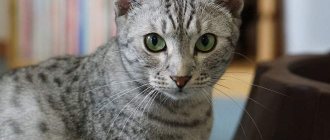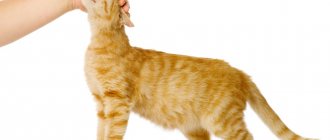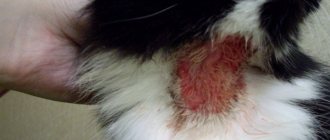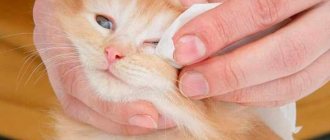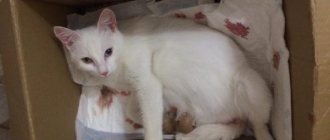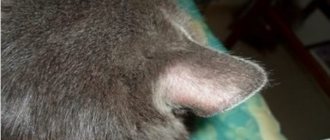If the owner notices discharge from the cat's anus, which looks like pus and has an unpleasant odor, there is no need to hesitate to visit the doctor. Often the cause of this pathological condition is inflammation of the paraanal glands located in the anus. However, the reasons for the appearance of pathological fluid under the tail may be different; one of the most dangerous is a malignant tumor of the anus. Therefore, for treatment to be effective, it is necessary to determine an accurate diagnosis and eliminate the original source of the problem.
Why does my cat leak fluid from her anus?
The main reason that provokes discharge from the anus in a cat is inflammation of the paraanal glands.
It has been noted that long-haired pets are more susceptible to this disease than their short-haired relatives. The inflamed area on the butt gradually increases in size, and pathological exudate accumulates inside the gland. If therapy is not started in a timely manner, a bacterial infection occurs, which threatens suppuration and the development of sepsis.
Other causes of inflammation of the anal area in cats
Self-cleansing
If you can’t get to a doctor, you can cleanse the glands at home.
Before you begin, you should put on old clothes or a protective robe. Glasses will also come in handy. It is better to carry out cleansing in the bathroom, since during manipulations an unpleasant-smelling liquid can splash in all directions.
First way
An assistant is needed who can secure the animal with a diaper or towel. The pet must be wrapped in fabric so that only the tail remains outside.
Then you need to squeeze the anus with your thumb and forefinger, helping with a napkin. Of course, you should wear gloves on your hands. Press on the glands located at 5 and 8 o'clock from the anus until the fluid comes out.
After cleaning, administer an anti-inflammatory suppository rectally. If necessary, cleaning is repeated after a certain period of time.
Second way
The above method is only suitable when the glands are not very enlarged. If the secretion has already thickened, you have to use a more complex and painful cleansing option.
It is necessary to wear protective clothing, gloves, and secure the pet. After this, lubricate your finger with Vaseline and insert it into the anus. From the inside, feel the nodules on the sides of the anus. Squeeze each of them alternately with your fingers. Squeeze out the secretion until the gland is empty.
Third way
Of course, not every owner is ready for such feats. That is why inflammation of the paraanal glands in cats, a photo of which will add to the determination to treat the animal, can be tried to be eliminated in another way. It is worth remembering that it can only be effective in the initial stages of the disease.
To do this, you need to lubricate the anus and nearby tissues with an ointment containing an anti-inflammatory agent (for example, Syntomycin). Be sure to put a collar on the animal to prevent it from licking the medicine. Put a candle with ichthyol at night. To prevent the animal from running straight to the toilet, it is necessary to hold the anus for a while, fixing the candle.
Types and symptoms
The nature of the discharge differs depending on the type of disease and the stage of its development. At the initial stage, due to inflammation localized in the anal area, the natural outflow of secretions from the glands is disrupted. When a bacterial infection occurs, yellow or white discharge that the cat leaves on the floor, carpet, and furniture is disturbing. At the time of defecation, the animal’s anus hurts, so the cat tries to visit the litter box less often, constantly screams, and worries. Other signs of the initial stage:
- extensive loss of fur;
- formation of ulcers and rashes under the tail;
- increased body temperature;
- fever.
The longer the disease progresses, the richer the color of the discharge becomes. Blood from the cat's anus indicates that the disease is advanced, and the animal needs urgent medical attention. Otherwise, the risk of developing an abscess increases, which poses a serious threat not only to the health, but also to the life of your four-legged friend.
Treatment of the inflammatory process
Treatment of inflamed paraanal glands should only occur in a veterinary clinic under the supervision of a physician after a thorough examination and assessment of the severity of the lesion.
Therapy involves cleaning, rinsing or removing the affected glands.
Cleaning
At the initial stage of the disease, cats undergo cleaning of the paraanal glands. Depending on the consistency of the accumulated secretion, this procedure can be carried out in the clinic or at home by a visiting veterinarian or an experienced breeder. In any case, cleaning brings discomfort to cats, so it will be more convenient to do it together.
Before cleaning the glands from accumulated secretions, it is necessary to palpate them to determine the consistency of the contents.
If the secretion is liquid, you can clean it yourself using an external method. The animal should be secured, the inflamed glands should be covered with a napkin and their contents should be carefully squeezed out - to do this, you need to squeeze the sides of the anus with two fingers and squeeze.
If a liquid with a very pungent and unpleasant odor appears, the procedure can be considered successful. At the end of the manipulation, the anal area must be treated with Chlorhexidine.
If the contents of the glands are dense, the procedure should only be performed by a doctor, since the cat will need internal cleaning, which is called the rectal debridement method. In such a situation, the index finger is inserted into the animal’s rectum, the outside is felt with the thumb and the contents are gently squeezed out. At the end of the procedure, the anus is treated with an antiseptic solution, and ¼ of an anti-inflammatory suppository is inserted inside.
Important! It is forbidden to clean cats that do not have inflammation of the paraanal glands, since such intervention can lead to disruption of their normal functioning.
Washing
Washing should be carried out exclusively by a veterinarian in a clinic setting. This procedure is indicated in the most severe cases, when a fistula or abscess has formed, and other methods do not bring results.
First, the cat's anal glands are cleaned mechanically. Then, under local anesthesia, a solution of potassium permanganate, Chlorhexidine or another antiseptic is injected into the anus using a catheter or syringe without a needle.
The procedure must be repeated several times until the flowing liquid becomes clear. This will indicate that there is no thick secretion or pus left in the paraanal glands. Next, the cat is given rectal anti-inflammatory suppositories, and the outside of the anus is lubricated with antiseptic ointment.
Important! Depending on the severity of the disease, the animal may also be prescribed antibiotic therapy.
Removal
In the most severe cases, when it is no longer possible to clean and washing does not bring results, veterinarians remove the paraanal glands from cats. Doctors also recommend this operation for pets who constantly suffer from blocked ducts.
Regular cleaning is a significant stress for cats, so removing the anal glands will make life easier for both owners and their pets.
The removal operation is performed under general anesthesia. The doctor makes 2 small incisions in the area where the anal glands are located, removes them along with the ducts and applies sutures. In the future, the owners need to treat the wound with a healing preparation, and also give the cat vitamins for speedy skin regeneration and antibiotics (if indicated, for 5–7 days).
Important! Owners need to ensure that the cat does not become constipated until the stitches heal. Otherwise, they may separate.
Diagnostics
If a cat has light, cloudy or bloody discharge from the anus, the anus itself is swollen and hurts when pressed, it is necessary to urgently take the animal to a veterinary clinic. An experienced veterinarian will be able to establish an accurate diagnosis during the initial examination. However, with other diseases, you may notice that ichor or blood is dripping from the anus. Therefore, additional diagnostic methods are necessarily prescribed:
- general blood and urine analysis;
- biochemistry;
- microscopic examination of feces;
- radiography;
- Ultrasound of organs located in the abdominal cavity.
Return to contents
What treatment is prescribed?
If a cat has a red bottom and is bleeding due to inflammation of the paraanal glands, complex treatment is necessary, which consists of the following procedures:
The drug will help heal existing skin damage under your pet’s tail.
- Mechanical cleaning. There is external and internal. In the first case, you can clean the anus yourself by pressing on the inflamed gland and releasing the exudate accumulated inside. If external cleaning is not possible, internal cleaning is performed, but this is done by a doctor on an outpatient basis.
- Disinfection. The next step is to treat the anus with an antiseptic that will help destroy the bacterial infection and prevent inflammation. It is recommended to drip Miramistin or Chlorhexidine solution onto inflammatory areas.
- Applying ointment. Levomekol or streptocidal ointment will help speed up the healing of wounds. It is recommended to apply the product first on a napkin or gauze, and then apply everything to the sore spot. Continue therapy until the damage heals and the red, inflamed spots disappear.
- Use of antibiotics. Prevents the formation of an abscess and the spread of inflammatory complications to surrounding tissues. It is recommended to use the drugs “Penicillin” or “Gentamicin”, which are best administered intramuscularly or subcutaneously.
Taking a vitamin complex will strengthen the weakened body of the fluffy.
During therapy, the animal's immunity can be severely damaged. In order to normalize the body’s protective functions and quickly recover from an illness, vitamin and mineral complexes are prescribed. If a relapse is observed and the cat is leaking from the rear hole again, repeated cleaning is carried out urgently. Often complications and relapses of the disease occur in sterilized or neutered cats.
Preventive measures
To ensure that the disease no longer bothers your pet, it is necessary to identify the original source of the problem and try to eliminate it. Often inflammation of the paraanal glands occurs due to improperly selected cat nutrition. In such a situation, it is better to contact a veterinarian who will help you create a balanced diet rich in essential vitamins, nutrients and other vital elements.
In addition, it is important to monitor the body weight of your four-legged friend and encourage him to spend time actively. You should not skip scheduled preventative visits to the doctor, during which you should describe in detail how your pet is behaving and whether it has any suspicious discharge. If relapses occur frequently in cats, to prevent complications, the veterinarian will advise removing the paraanal glands, which will save the pet from suffering.
Animals have illnesses that resemble human ones in their causes and symptoms. Discharge always signals some problems in the cat or changes in the body.
Prevention of inflammation of the paraanal glands
Inflammation and abscess of the paraanal glands are a serious blow to your cat's health. However, it is possible to avoid it. The main thing is to follow simple recommendations for prevention from experienced veterinarians.
Adviсe:
- Your pet should lead an active lifestyle (in accordance with its age). If you don't have much time, special toys and exercise equipment for cats will help with this.
- If your animal's anal glands are often clogged, consult a specialist and discuss the issue of removing them.
- Try to avoid cheap liquid food and do not give your pet small bones, as well as foods that can cause gastrointestinal injury.
- At the first signs of inflammation, consult a doctor. Don't forget about regular preventive examinations.
- Carry out anthelmintic treatment once every 6-12 months. This completely eliminates the possibility of developing parasitic diseases.
Inflammation or abscess of the paraanal glands is dangerous to the health and life of the cat. A seemingly insignificant problem can lead to dangerous consequences, including death. That is why we strongly recommend that you follow preventive measures, and if the first signs of inflammation appear, contact your veterinarian immediately!
What kind of discharge does a cat have?
The first group of discharge is associated with the cat’s pregnancy and impending birth. If the cat is pregnant, then the presence of ichor is normal. Also, discharge appears when a cat comes into heat. Liquid flows from under the tail; it is a white or brown discharge. They will be accompanied by changes in behavior: meowing loudly, arching his back and taking a position for intercourse. The animal shows strong affection towards its owners. They have a translucent consistency, odorless and colorless.
Possible reasons
Possible reasons The reasons why a cat bleeds from under its tail are quite varied. One of the main reasons is the onset of sexual heat or estrus (heat). Estrus is a physiological process in the body of a healthy cat that occurs in the appropriate period.
The beginning of estrus is a kind of signal that the animal is ready for mating and further procreation. The appearance of blood in small quantities released from the area of the pet's loop is not dangerous, but indicates puberty.
In addition to physiological ones, there are a number of other reasons why a cat bleeds from under its tail. The main ones are:
- Inflammatory pathological processes in the gastrointestinal tract. The nature and extent of the lesions can only be determined after a thorough examination in a veterinary clinic using special equipment and tests. The appearance of blood under the tail in some cases is a symptom of tumor processes in the rectum, damage to the large intestine, or trauma to the paraanal glands.
- Bleeding in the loop area is possible due to damage to the uterine arteries. Occurs with inflammation of the endometrium, neoplasms of a malignant and benign nature, pyometra. In addition to blood under the tail, the animal experiences general weakness, apathy, and increased body temperature. It all depends on the degree of the pathological process.
- Spontaneous termination of pregnancy. Natural abortion is more often diagnosed in the early stages of gestation, so that the owner sometimes does not notice dramatic changes in the pet’s behavior. The cat, being a naturally clean creature, constantly licks the loop area, removing secretions. Kittens that die in the womb do not always emerge completely from the uterine cavity, and inflammation processes are accompanied by the release of large amounts of blood. In some cases, when the pathology is neglected, purulent discharge appears.
- Uterine bleeding due to mechanical injuries. As a result of injury to the large uterine arteries, the cat drips blood from under its tail, and the general condition of the animal deteriorates sharply. Large blood loss can be fatal in the absence of proper care.
- Formation of stones in the genitourinary system. The development of urolithiasis occurs in representatives of domestic cats often in the clinical practice of veterinarians. The disease progresses with violations of the diet and consumption of drinking water that has high hardness. The release of stones provokes trauma to the mucous membrane and bleeding. The condition of an animal with urolithiasis requires immediate intervention by a veterinary specialist.
Physiological reasons
Physiological are considered reasons that cause discharge due to the characteristics of the body. Before giving birth, the female will have a plug, which is also a hard clot of mucus that comes out before giving birth. It does not bode well: it is necessary to “remove” everything unnecessary from the surface of the labia and prevent the occurrence of infections as a result of the introduction of harmful bacteria during childbirth.
After your cat gives birth, she may continue to have mucus coming from her vaginal opening and anus for some time. Color – reddish or dark brown interspersed with greenish color. The norm is 3 weeks after birth. Due to the fact that during childbirth the discharge is red (the cat has bloody discharge), after the birth of the kittens the mucus will also have a reddish tint, which will gradually turn into a brown tint and disappear.
Reference! True, during pregnancy, yellow mucus sometimes comes out - amniotic fluid.
But not everything is as simple as it seems. There are much more dangerous secretions that indicate the presence of health problems. If they are not related to pregnancy, then they are not difficult to recognize. The next step is to determine the type, cause and prescribe the correct treatment.
Dangerous diseases arise as a result of infections that enter the body through the external environment, contact with other animals and sexual intercourse.
What does white discharge mean?
The appearance of white discharge from the anus and organs of vision is always alarming, since in most cases the color change is associated with the presence of pus and inflammation. If mucus was found on the loop, this may be normal.
Physiological norm
The following signs may not indicate the presence of the disease:
- Transparent or slightly whitish mucus near the loop. May be released during estrus. Color and consistency change due to hormonal changes and the functioning of the reproductive organs. There is no unpleasant odor, the secretion may be thick.
- Discharge from the uterus after childbirth. Present for several days. They can range in color from black to greenish. Sometimes residual traces are present for 2-3 weeks. It is important not to confuse normal discharge in the postpartum period with pathological ones. If the placenta has not been delivered, the cat will constantly have watery mucus, sometimes mixed with blood.
- Whitish discharge from the loop of a pregnant cat is odorless and impurities of pus. Most often they appear 2-3 weeks before birth. Often this type of discharge is confused with pathological, so it is recommended to have the animal checked by a veterinarian.
- Transparent discharge from the eyes in a small amount. They may appear after sleep or upon contact with an irritant, such as dust. They have a liquid consistency.
In rare cases, the appearance of a small amount of mucus in the stool is considered normal. This can happen if there is insufficient water intake while feeding dry food. In such cases, mucus is secreted to protect the mucous membranes of the gastrointestinal tract from injury from coarse feces.
However, you need to pay attention if this happens often: constant irritation of internal tissues can provoke the development of diseases.
Pathological changes in the body
The presence of white discharge may indicate the following pathologies and abnormalities:
- Infectious diseases of the genitourinary system. White or yellow discharge from the urethra may be associated with infection with chlamydia, toxoplasmosis, mycoplasmosis, etc. The mucus in most cases has an unpleasant odor. Sometimes there are no symptoms. Infection most often occurs during mating, so you should carefully select a partner for your cat.
- Pyometra. It is characterized by the presence of an inflammatory process with abundant formation of pus. There are several types of pyometra. If a cat's white discharge gradually comes out of the loop, this is an open form. It is easier to diagnose and treat. In the closed form, the discharge does not leave the uterus, which leads to its rupture and the further development of sepsis. Such pyometra is not always detected on time, since many owners mistake an enlarged abdomen and symptoms of intoxication for pregnancy.
- Oncology. Tumors occur more often in older cats. They cause white discharge from the urethra or anus. If the tumor is located in the intestinal lumen, its individual fragments may be present in the stool. In the early stages, cancer is asymptomatic, but later common symptoms appear: refusal to eat, anxiety, weight loss, etc.
- Development of complications after surgery. In such cases, the appearance of white discharge is associated with tissue infection. Most often, repeated surgery is required to eliminate the consequences. If you do not help the animal, the infection will develop rapidly.
- Vaginitis. Characterized by inflammation of the mucous membranes of the vagina. In most cases, the disease is asymptomatic, but some cats experience copious clear or whitish discharge. The animal experiences discomfort and often licks itself, trying to alleviate the condition.
- Phlegmon. Inflammation occurs, accompanied by the formation of abscesses. Mucus mixed with pus comes out of the urethra. The animal experiences pain and the temperature rises due to inflammation.
- Pathologies of the organs of vision. Most often, the appearance of whitish mucus from the eyes is caused by infections. They can develop independently or as a result of injury. The discharge is accompanied by redness of the protein, inflammation of nearby tissues, itching, the appearance of crusts, etc.
- Cystitis. Cystitis. Often has an infectious nature of origin. First, the animal experiences problems with urination. When the mucous membranes are damaged, blood first appears in the urine, and later pus, which is excreted only in the urine.
- Kidney diseases. These include pyelonephritis, glomerulonephritis, urolithiasis, etc. If internal tissues are damaged due to inflammation, microbial activity, or injury from stones, pus and blood appear in the urine.
- Gastrointestinal pathologies. In diseases of the stomach, intestines, pancreas and liver, discharge is found in the stool. In the initial stages it is clear mucus, later it becomes white and blood is added. In advanced cases, neighboring organs may become inflamed, and then discharge from the loop may appear.
- Inflammation of the anal glands. Accompanied by the appearance of purulent discharge from the anus and in the feces. The animal licks the anal area and can move its butt on the floor. Due to the discharge, the fur near the tail becomes wet. In advanced cases, fistulas form, from which pus comes out.
- Parasites. Most often, discharge appears in the stool. This happens due to worms. In feces you can sometimes find not only mucus, but also worms or their fragments. If the infection is severe, the cat begins to vomit, the hair falls out and becomes dull.
Dangerous diseases
Some brown, pink, clear and white discharge from a cat indicates dangerous diseases in your beloved pet. If she is not helped in time, the disease will progress, and ultimately some ailments lead to death, infertility and many other complications. Most often, veterinarians identify 7 diseases that affect animals. Some diseases occur through the entry of bacteria into the urethra and urethra.
Pyometra
Most often, this disease appears in older cats. When 2-3 months pass after estrus and the cat has not been fertilized, bacteria begin to develop in the uterine area, which can enter the body long before the onset of estrus. The fact is that without caring for the sperm and the development of the fetus, cysts form. As a rule, the main symptom of bacteria in the body is strong discharge, which can appear both during and after estrus. You can avoid this by sterilizing your cat on time.
The disease can be provoked by deterioration of hygiene standards during estrus, childbirth or operations. Risk factors: low physical activity of the cat, susceptibility to disease, inflammation, uncontrolled mating and much more. Along with the discharge, the cat's belly is rounded (lack of pregnancy), severe thirst and frequent trips to the toilet, bad behavior due to poor health, disheveled fur, and so on.
As the disease progresses, loss of appetite, vomiting, and diarrhea appear. Discharge with this disease is brown or white-brown in color.
Uterine trauma
Inflammation and trauma to the uterus occur as a result of various diseases, as well as birth injuries. The disease can progress and be accompanied by discharge and pain. This disease is also fatal. The more the disease progresses, the larger and more abundant the discharge will be. They cannot be left unattended, because they will lead to the imminent death of the pet.
The cat will constantly lick the genital opening; when the disease reaches the last stage, the animal will no longer have time to constantly lick the pus. Purulent discharge will be very noticeable on the floor where the pet sits, on the back of the fur. As with the previous illness, there will be severe thirst and frequent trips to the toilet, but the cat will practically stop eating. The volume of the abdomen will increase at high speed and in a few hours can reach such a size that it will look extremely unnatural. The cat will breathe very heavily, the owner will certainly pay attention to this.
Note! Frequent urination occurs because the slightest accumulation of urine in the bladder causes very noticeable pain. Bacteria can settle in the uterus 1-2 months before manifestation.
Vaginitis
The disease is characterized by swelling of the internal walls of the vagina and the first stage of the disease occurs calmly for the owner, since the cat will feel some discomfort, but it will not show it.
Symptoms in the second stage:
- Piteous meowing while going to the toilet;
- Attention from surrounding cats in the absence of heat at the moment;
- The pet will try to scratch the labia in different ways: on the carpet, furniture, or even begin to bite them;
- Grayish and white discharge and so on.
Endometritis
Another inflammatory disease of the uterus. Pathogenic microbes enter the uterus, multiply and cause inflammation. The first complication is poor health, problems with going to the toilet. The second complication is loss of reproductive ability. Deaths as a result of this disease are common. Occurs with low body resistance (weak immunity), postpartum complications, hormonal imbalance. It happens when animals take hormonal pills and they provoke various diseases.
Hydrometer
The uterine cavity accumulates fluid and mucous exudate. A less dangerous disease that shows few symptoms. The animal may not have sexual cycles (there will be no estrus and no subsequent pregnancy). As with any other disease, a diagnosis can only be made by a veterinarian, and discharge from a sterilized cat is almost the only noticeable symptom in the presence of such a disease. Treatment may sometimes require surgery.
Why does my cat have white discharge? Will they go away on their own or do I need a veterinarian?
A liquid substance sometimes appears on the external genitalia of cats. The type of these secretions indicates the reasons why they are formed:
- watery;
- transparent;
- cloudy;
- purulent;
- mixed with blood.
First, we will talk about cases where the discharge is normal and physiological.
- Alexey Shevchuk
therapist, neurologist
certificates reviews
- Aigul Sopova
therapist, surgeon
certificates reviews
veterinarians at the clinic
- Estrus. In this case, the discharge is transparent, without an unpleasant odor. Of course, you won’t confuse estrus with anything, because the cat characteristically arches its back and behaves restlessly.
- Pregnancy. Until the third week of pregnancy, clear, thick mucus may appear along with the urine. This is nothing more than a mucus plug that forms in the body of a pregnant female. Until the sixth week, clear fluid appears - excess amniotic fluid.
But the following options are associated with pathological processes.
- White discharge in a cat may be associated with vaginitis. This is an inflammatory process in the vagina. It can occur due to an attack of streptococcal infection, staphylococcus or E. coli.
- Endometriosis is an inflammatory disease in the uterus. At first, the discharge is light and clear, but can soon become copious, thick and foul-smelling.
- Bloody marks under the tail of a pregnant cat indicate that a miscarriage may occur. And in the postpartum period, this phenomenon is due to the fact that the placenta has not completely come out.
- When a cat goes to the toilet with white discharge, and other signs appear - a bloated abdomen, frequent urination, then pyometra can be suspected.
- Pyometra, a common inflammatory disease in cats aged 3 to 8 years, is an accumulation of pus in the uterus. Doctors distinguish open and closed forms of this disease.
| Open | The cervix is open. A purulent substance is released outside. |
| Closed | Pus does not leave the uterus, but accumulates in it. There is no discharge from the genitals. |
The closed form is considered very dangerous, since in its advanced form it leads to inflammation of the uterus, peritonitis and, ultimately, death.
- Pyometra often becomes a complication after untreated chronic endometriosis. It is also fraught with infertility, sepsis, and peritonitis.
Veterinarians often observe white discharge from a cat’s loop (that is, from the genital area) after taking hormonal medications. It is no coincidence that veterinarians recommend promptly sterilizing domestic cats. This will not only save them from estrus and other unpleasant manifestations of sexual desire, but will also serve as the prevention of many diseases. If owners, instead of surgery, give their pet hormonal antisex pills, then sooner or later they will cause irreparable harm to the cat’s health, leading to benign or malignant tumors and inflammatory processes.
Video: Cat discharge
Diagnostics
To conduct a quality diagnosis, the owner must contact a professional veterinarian. Why is diagnosis by a doctor important:
- He will make an accurate diagnosis based on the possible causes of the disease. The owner can hardly identify the causes for sure, or does not search for the causes at all and buys medications in accordance with the symptoms. But one symptom can indicate several diseases at once.
- Depending on the age, character, weight, breed, causes and stage of the disease, the veterinarian prescribes treatment. Complex diseases often require not just some medications, diets and observation, but step-by-step treatment in different ways. It is not uncommon for treatment to require surgery.
Independent actions may turn out to be wrong and cause more harm to the animal.
Note! Observation by a specialist is the most reliable way to cure an animal without complications or death in the shortest possible time.
Diagnosis is carried out through examinations, tests, ultrasound and the use of special medical equipment to examine internal organs. Continuous specialist supervision may be required.
Diagnostics reveals more causes and problems of the body at more serious stages, but this does not mean that when a disease occurs, you need to wait until the pet becomes very ill. The more serious the stage, the longer, more difficult and more expensive the treatment, and the chances of fully restoring health become less.
How to help your pet
Loving owners always strive to help their pet. Whatever the methods, they must first of all be safe. If a cat is in heat, you need to encourage her natural urges and find a cat to breed. If you really don’t want your pet to have offspring, then you can “bring her back to her senses” with the help of special medications. For example, a special ointment that is applied to the nose every day. The animal will quickly return to its usual behavior and stop meowing loudly and chasing its owners.
Reference! If the discharge is not associated with estrus, then the best thing the owner can do is take the cat to the veterinarian, or call him at home (but if the disease is serious, then transportation to the clinic will be required).
The above diseases, after reading, should lead to the conclusion that the discharge indicates serious and dangerous diseases. Therefore, it is almost impossible to help your pet at home. Loss of appetite, baldness, deterioration in general condition and other dangerous symptoms cannot be “removed” on your own.
Discharge during pregnancy and childbirth
The owner should always be attentive to the cat during its pregnancy and especially during childbirth. Purulent discharge in a pregnant cat signals that something is going wrong in the body and the help of a specialist is needed.
It is known that during pregnancy and even during childbirth, clots form in cats, but they usually have either translucent shades or a greenish color. Their consistency is either similar to mucus, or it is a liquid of a certain color.
Prevention is the key to health
To keep your pet healthy, you need to follow preventive measures. A few basic rules:
- Careful observation of changes in the animal’s appearance and behavior;
- Regular visits to the veterinary clinic for a professional examination of the animal;
- If the cat has already had illnesses, you need to use prophylactic agents in the form of tablets or drops;
- Limit your stay on the street in areas where there are many homeless animals;
- Examine your pet yourself and eliminate foods that may cause disease.
The period of pregnancy and after childbirth requires special attention: during these periods the body is more vulnerable to the emergence of dangerous diseases that are primarily associated with the uterus. For example, after giving birth, you can call a veterinarian to your cat’s home for an examination; in no case should you allow the cat to be in hygienically unsuitable places in the first hours and days after birth: the street, the basement, contaminated places in the house. The same rules must be followed during childbirth.
If a cat has brown discharge from under its tail, it may be noticeable in the places where it sits. In some diseases, the discharge is very light and the animal will constantly lick it off. In this case, you need to pay attention to the fact that the cat will often begin to lick its perineum. In the second part of the disease or in severe stages, the mucus does not have time to be “cleaned up” by the cat itself and remains on the floor, furniture or rug. If your cat is leaking white fluid from under its tail, you should immediately consult a doctor.
Causes of dangerous discharge
Dangerous purulent discharge in a cat always requires treatment and careful attention. There are several reasons for their occurrence. First of all, these are any types of infections, as well as various inflammations, cancer and other equally serious causes.
A pregnant cat always requires special attention, as complications may arise during childbirth, in which case part of the placenta remains inside the animal. Most often, purulent vaginal discharge in a cat indicates that the process of decomposition has begun in its body. To cure a sick animal, surgery is necessary.
Another reason may be an infectious disease of the genitals. If a cat has purulent discharge with a reddish tint, then most often this indicates that pathogenic processes are occurring in the animal’s uterus or in its bladder. They are easy to distinguish, since then such secretions do not have any odor, but are characterized by a peculiar and thick consistency. As soon as such signs appear in a cat, you should immediately contact a veterinarian.
Purulent discharge from a cat's loop, the treatment of which requires special attention, can also occur with cancer.
You should always pay attention to the smell of the discharge. Thus, a cat’s purulent discharge from the loop (vagina) has a peculiar smell, which will indicate that destructive processes are taking place in the cat’s body.
The cause of discharge with pus can also be inflammatory processes of the mucous membranes. You should carefully monitor your cat's behavior, as at this time she becomes restless and even aggressive. Can lick itself often and for a long time. Such a cat will be reluctant to go to the toilet, so it will show aggression and behave anxiously. This is due to the fact that she experiences pain when urinating.
If there was an injury to the bladder or uterus, then the cat may also have purulent discharge. Any injury to an animal will be accompanied by discharge, so the owner must provide it with immediate medical attention.
Types of discharge
There are different types of white discharge in domestic cats. Some are a physiological norm, others are a sign of a pathological process. Whitish discharge is sometimes called “leucorrhoea.” Types of white discharge:
- Whitish, almost transparent, odorless leucorrhoea.
- White curdled flakes.
- Milky white discharge with an unpleasant odor.
- White-yellow discharge with signs of pus and an unpleasant odor.
The life period of the cat when leucorrhoea was noticed (postpartum period, estrus, etc.) is of great importance. This helps to understand what caused it.
Physiological reasons
There are several natural reasons why a cat may have white discharge. The most common:
- Estrus. During this period, whitish, viscous leucorrhoea may be observed. This is the norm. Indicates that the cat is ready to mate. The time of estrus can be accurately determined, as the cat meows loudly, raises its tail, and often licks itself. This period lasts 2-5 days.
- Pregnancy. While pregnant, your cat may experience white discharge. Only those leucorrhoea that do not contain impurities of pus, blood and are not accompanied by an unpleasant odor are considered normal. Typically, whitish discharge appears in the second half of a cat's pregnancy.
- Postpartum period. After the birth of kittens, cats experience white or cloudy discharge for some time. If there is no foul odor or pus, then everything is normal. Bloody streaks do not pose a threat if they go away on their own a few days after birth.
Natural discharge is not a cause for concern and goes away on its own within a few days.
Pyometra
If estrus does not stop for a long time, a uterine infection may be suspected in the cat. This is a serious disease that threatens the life of the animal. It is impossible to do without veterinary control.
© shutterstock
Pyometra occurs due to hormonal changes that occur in the genital tract of a mature cat. The cause of the disease is often pregnancy that does not occur within several heat cycles. During estrus, the cervix is slightly dilated. Because of this, bacteria enter the reproductive organ. If the walls of the uterus are thickened due to unsuccessful attempts to get pregnant, bacteria begin to develop in them.
The infection manifests itself as purulent vaginal discharge. They can be noticeable under the tail, on the fur, on the bed.
If the disease is confirmed, the specialist will recommend removal of the uterus and appendages.
Pathological causes
Pathological whitish discharge is often accompanied by an unpleasant odor, an admixture of blood or pus. There may be several reasons:
- Infections transmitted through mating. The most common: mycoplasmosis, toxoplasmosis, chlamydia, feline immunodeficiency virus. Excessive leucorrhoea with an unpleasant odor can be a symptom of these diseases. Although in approximately half of the cases, sexually transmitted infections are asymptomatic.
- Pyometra. This is an inflammatory process in the uterus, accompanied by the accumulation of large amounts of pus. There are two types of pyometra: open and closed. Closed pyometra is the most dangerous, since the purulent contents remain in the organ cavity. In the open version, whitish discharge mixed with pus regularly flows from the animal’s genitals. Pyometra is also characterized by other symptoms: fever, lethargy, loss of appetite.
- Fragments of amniotic membranes remaining in the uterus. In some cases, after childbirth, particles of membranes may remain in the uterine cavity. If an infection occurs, the inflammatory process begins. White, thick discharge from the uterus appears (often with pus or blood streaks). This situation is extremely dangerous for the pet’s health, so you should immediately contact a veterinarian.
- Oncology. Malignant neoplasms are especially common among older animals. The tumor provokes pathological whitish discharge from the uterus. In addition, the cat becomes restless, refuses to eat, and rapidly weakens.
- Consequences of the operation. If the operation is unsuccessful, an infection may be introduced into the pet’s body. Shortly after infection, the cat begins to have a cloudy white discharge. If you do not pay attention to this, the severity of the condition worsens. The matter may end in the death of the pet.
- Vaginal phlegmon. With this disease, a cat has a white discharge accompanied by the appearance of pus or fragments of the vaginal mucosa. The animal suffers greatly and the temperature rises.
- Vaginitis. This is an inflammation of the mucous membranes of the vagina. The process may be asymptomatic, but in advanced cases, a clear or whitish substance is released from the vagina.
All of the diseases described are dangerous to the cat’s health. If left untreated, they can be fatal.
Natural cause in cats
Your cat may have a wet tail due to the onset of the reproductive estrous cycle, popularly called estrus. A similar condition occurs in cats during sexual arousal. At this time, the animal’s body prepares for the process of mating, fertilization and pregnancy.
Estrus occurs in 4 stages:
- proestrus - takes 1-3 days, the cat attracts cats to her, but does not let them get close;
- estrus – lasts about 5 days, mating occurs;
- diestrus – 2-19 days, excitement subsides, most often pregnancy occurs;
- anestrus - sexual rest.
A discharge under the tail appears during the mating stage. At this time, the animal does not look like itself, purrs, and shows excessive tenderness. It often licks its genitals, from which a clear secretion is released. The first heat can begin at the age of 4 to 18 months, depending on the breed. What to do in this case?
There may be several options. The cat can be matched with a male, sterilized, or wait until everything goes away on its own. But for this you will have to be patient. Typically, estrus goes away within 5-15 days. If this does not happen, you should contact your veterinarian.
When to see a doctor
Natural excretions do not pose any threat to the health of cats. But in case of pathological leucorrhoea, it is important to immediately contact a veterinarian. What signs should you be wary of? Veterinarians explain:
- If the duration of leucorrhoea is more than 7 days.
- When there is an unpleasant odor.
- If the discharge acquires a yellow-green tint or blood is mixed.
- When other symptoms appear: anxiety, fever, loss of appetite.
Since your pet often licks itself, it can be difficult to detect pathological discharge. But the very fact of frequent licking of the genitals should alert you. In such a situation, it is important to monitor the pet and monitor any changes in well-being.
Wet tail (colibacillosis)
Colibacillosis is an infectious disease accompanied by enteritis, also known as “wet tail”. Causes pathology E. coli. Normally, E. coli is present in the animal’s body, but under certain circumstances the number of bacteria can exceed the norm, resulting in disease.
It is assumed that the infection is transmitted through household items, through contact of a sick animal with a healthy one, and through airborne droplets.
Most often, hamsters, rats and mice suffer from the disease; Rabbits, guinea pigs and larger rodents get sick less often.
Diagnostics
Diagnosing cat diseases is not difficult, since veterinary medicine has a wide variety of diagnostic techniques. Laboratory diagnostic methods are especially informative.
Most often, vaginal discharge is examined. A smear or scraping is taken. The obtained materials are examined by various laboratory methods (microscopy, cultural culture, etc.). Cultural culture allows not only to determine the type of bacteria, but also to select the most suitable antibiotic.
They also take blood for analysis. The study is carried out in different ways, depending on what disease is suspected. The most popular methods: ELISA, PCR.
In order to detect malignant neoplasms, ultrasound or X-ray examination with a contrast agent is used. In difficult cases, an MRI may be prescribed. But such a study can only be done in large veterinary clinics.

